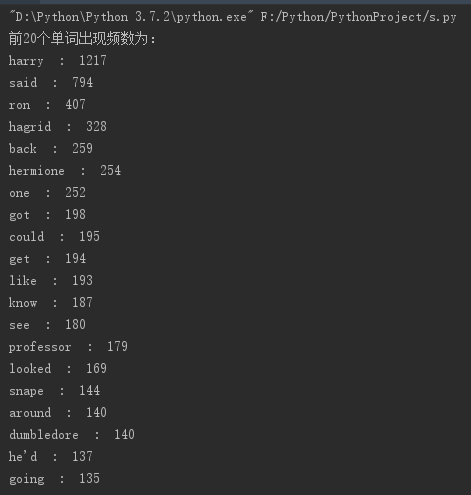【大数据】复合数据类型,英文词频统计
作业的要求来自于:https://edu.cnblogs.com/campus/gzcc/GZCC-16SE2/homework/2696
1.列表,元组,字典,集合分别如何增删改查及遍历。
列表:
list = ['列表', 27,'列表',27] #这是一个列表 #增 list.append('append') # 增加元素到列表结尾 list.extend(['extend','扩充列表']) # 添加指定列表的所有元素 list.insert(0, '插入元素') #在指定位置插入一个元素 print(list) #删 list.remove('列表') #删除列表中值为'列表'的第一个元素 list.pop() #删除最后一个元素 list.pop(1) #删除指定位置元素
del list[2:4] #删除从2到4的元素 list.clear() #删除列表中的所有项 print(list) #改 list[0] = 'list' print(list) #查 list.index('列表') #返回第一个值为x的元素的索引 print(list)
#遍历
for i in list:
print(i)
元祖:
tup = ('Google', 'Runoob', 1997, 2000); #这是一个元祖 #元组中的元素值是不允许修改的,但我们可以对元组进行连接组合 tup1 = (1,2,3); tup2 = ('a', 'b','c') # 创建一个新的元组 tup3 = tup1 + tup2; print(tup3)
#访问元祖
print ("tup1[0]: ", tup1[0])
#遍历
for i in tup1:
print(i)
字典:
dict = {'a': '1', 'b': '2', 'c': '3'} #这是一个字典
#删
del dict['b'] # 删除键 'b'
dict.clear() # 清空字典
del dict # 删除字典
#改
dict['a'] = '9'; # 更新a
#增
dict['d'] = '4' # 添加信息
#查
print(dict['a'])
#遍历
for i,j in dict.items():
print(i, ":\t", j)
集合:
set1 = {1,2,3} #这是一个集合
set2 = set((1,2,3)) #这也是一个集合
print(set1)
print(set2)
#增
set1.add(4)
print(set1)
#删
set2.remove(1) #移除值为1的元素,如果不存在则会发生错误
set2.discard(1) #移除值为1的元素,如果不存在不会发生错误
set2.pop() #随机删除一个元素
set2.clear()
print(set2)
#查
print(1 in set1)#存在则返回True
#集合无序,不能修改指定的元素
#遍历
for num in set1:
print(num)
2.总结列表,元组,字典,集合的联系与区别。参考以下几个方面:
- 括号
- 有序无序
- 可变不可变
- 重复不可重复
- 存储与查找方式
| 列表 | 元祖 | 字典 | 集合 | |
|
括号 |
[] | () | {} | {} |
|
有序无序 |
有序 | 有序 | 无序,自动正序 | 无序 |
|
可变不可变 |
可变 | 不可变 | 不可变 | 可变 |
|
重复不可重复 |
可以 | 可以 | 可以 | 不可以 |
|
存储与查找方式 |
值 | 值 | 键值对(键不能重复) | 键(不能重复) |
3.词频统计
-
1.下载一长篇小说,存成utf-8编码的文本文件 file
2.通过文件读取字符串 str
3.对文本进行预处理
4.分解提取单词 list
5.单词计数字典 set , dict
6.按词频排序 list.sort(key=lambda),turple
7.排除语法型词汇,代词、冠词、连词等无语义词
- 自定义停用词表
- 或用stops.txt
import pandas as pd from nltk.corpus import stopwords #获取停用词 stopwords = stopwords.words('english') f = open("Harry Potter and The Sorcerer's Stone.txt","r") text = f.read()#读取文件 f.close()#关闭文件 #文件处理 dict = {}; text = text.lower();#小写转化 sep = ".,?:…—“”"; for s in sep: text = text.replace(s, " "); #以空格替换符号 list = text.split();#空格分割单词单词 for l in list: dict[l] = list.count(l);#获取单词数目 for s in stopwords: if s in dict.keys(): dict.pop(s);#删除停用词 d = sorted(dict.items(),reverse = True,key = lambda d:d[1]); #排序 print("前20个单词出现频数为:") for i in range(20): print(d[i][0]," : ",d[i][1]); pd.DataFrame(data = d).to_csv('wordcount.csv',encoding = 'utf-8') #保存为.csv格式
8.输出TOP(20)

- 9.可视化:词云
排序好的单词列表word保存成csv文件
import pandas as pd
pd.DataFrame(data=word).to_csv('big.csv',encoding='utf-8')


线上工具生成词云:
https://wordart.com/create




